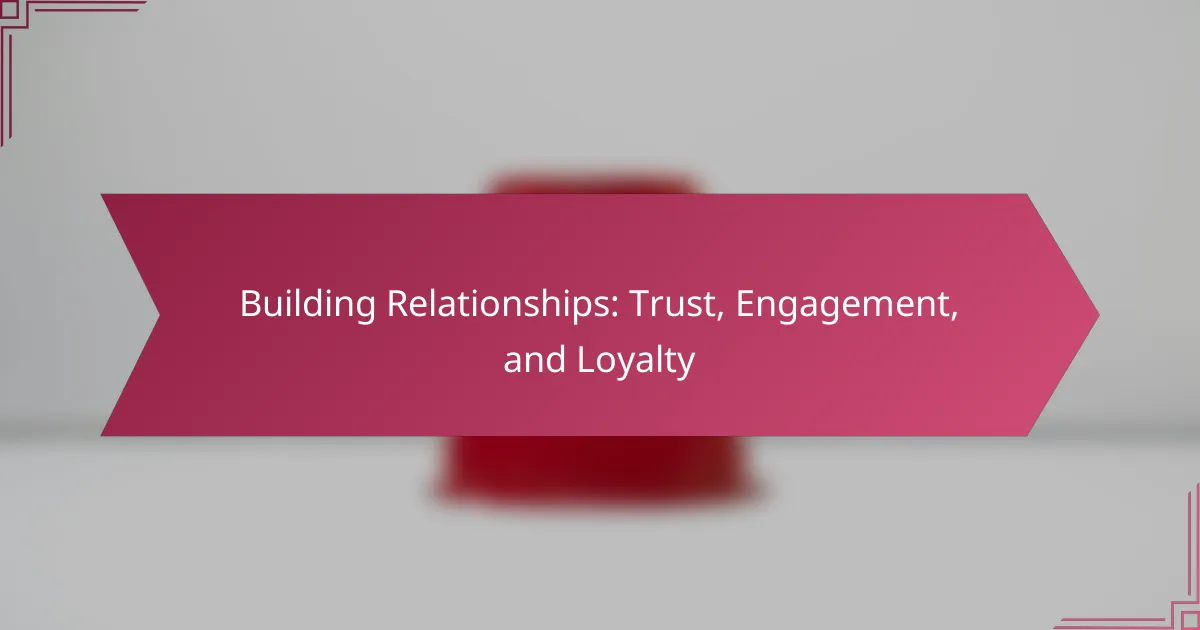Building strong relationships is essential for fostering trust, engagement, and loyalty. By being reliable and open, individuals and businesses can establish trust over time, while meaningful interactions and personalized strategies enhance engagement. Ultimately, creating rewarding experiences and maintaining consistent communication can lead to lasting customer loyalty.
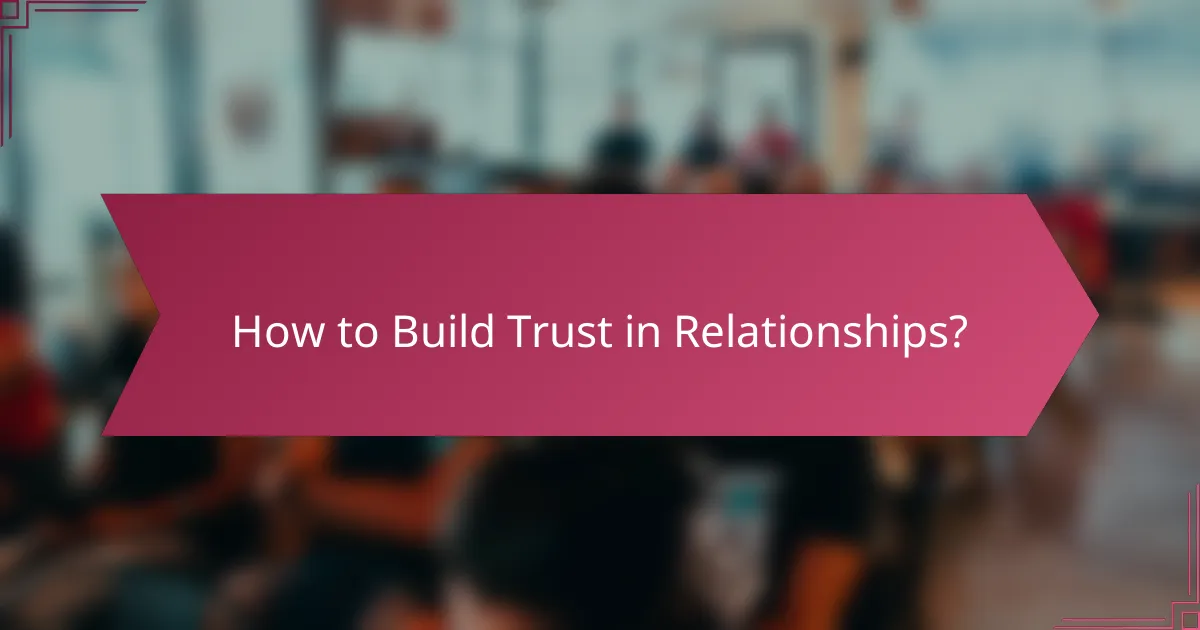
How to Build Trust in Relationships?
Building trust in relationships involves being reliable, open, and honest. Trust is established over time through consistent actions and communication that demonstrate integrity and respect.
Transparency and honesty
Transparency and honesty are fundamental to establishing trust. Being open about your intentions and sharing relevant information fosters a sense of security in relationships. For example, if you are working on a project with a colleague, keeping them informed about your progress and challenges can strengthen your partnership.
It’s essential to avoid withholding information or sugarcoating situations, as this can lead to misunderstandings and erode trust. Aim for clear and straightforward communication to build a solid foundation.
Consistent communication
Consistent communication is key to maintaining trust. Regular updates and check-ins help keep everyone on the same page and demonstrate your commitment to the relationship. Whether through emails, meetings, or casual conversations, make an effort to stay connected.
Establishing a routine for communication can be beneficial. For instance, setting weekly catch-up meetings can ensure that both parties feel heard and valued, reinforcing trust over time.
Delivering on promises
Delivering on promises is crucial for building and maintaining trust. When you make a commitment, follow through to show that you are dependable. This applies to both personal and professional relationships.
To avoid overcommitting, set realistic expectations. If you foresee challenges in meeting a deadline, communicate this early and renegotiate the terms rather than risking a broken promise.
Active listening
Active listening involves fully engaging with the speaker and demonstrating that you value their input. This practice not only helps in understanding their perspective but also builds trust by showing that you care about their thoughts and feelings.
To practice active listening, maintain eye contact, nod in acknowledgment, and summarize what the other person has said. This feedback loop reinforces that you are genuinely interested in the conversation.
Empathy and understanding
Empathy and understanding are vital for fostering trust in relationships. Being able to put yourself in someone else’s shoes allows you to respond appropriately to their needs and emotions. This connection can significantly enhance the trust between individuals.
When conflicts arise, approach them with empathy. Acknowledge the other person’s feelings and work collaboratively towards a resolution. This approach not only resolves issues but also strengthens the bond of trust.
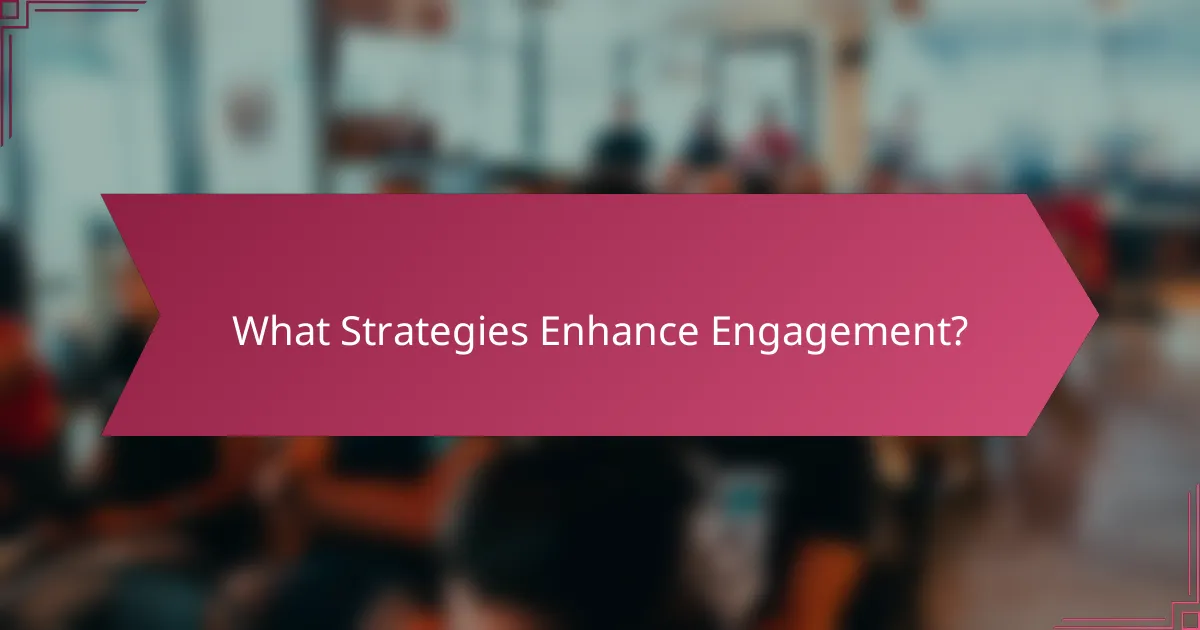
What Strategies Enhance Engagement?
Enhancing engagement involves implementing strategies that foster meaningful interactions and connections with your audience. Key approaches include personalized interactions, leveraging social media, creating valuable content, and encouraging feedback.
Personalized interactions
Personalized interactions significantly boost engagement by making customers feel valued and understood. Tailoring communications based on individual preferences or behaviors can lead to stronger connections.
For example, using a customer’s name in emails or recommending products based on previous purchases can enhance their experience. Aim for a balance between automation and personal touch to avoid sounding generic.
Utilizing social media platforms
Social media platforms serve as powerful tools for engagement, allowing brands to connect with their audience in real-time. Regularly posting updates and responding to comments fosters a sense of community.
Consider which platforms your target audience frequents most. For instance, Instagram may be ideal for visual content, while LinkedIn is better for professional networking. Tailor your content accordingly to maximize impact.
Creating valuable content
Creating valuable content is essential for keeping your audience engaged and informed. This includes blog posts, videos, and infographics that address their interests and needs.
Focus on quality over quantity; aim for content that educates or entertains. Regularly updating your content can keep your audience coming back for more, enhancing loyalty over time.
Encouraging feedback
Encouraging feedback is crucial for improving engagement and building trust. Actively seeking input from your audience shows that you value their opinions and are committed to enhancing their experience.
Implement surveys, polls, or feedback forms to gather insights. Be responsive to the feedback received, and communicate any changes made as a result to reinforce the relationship with your audience.
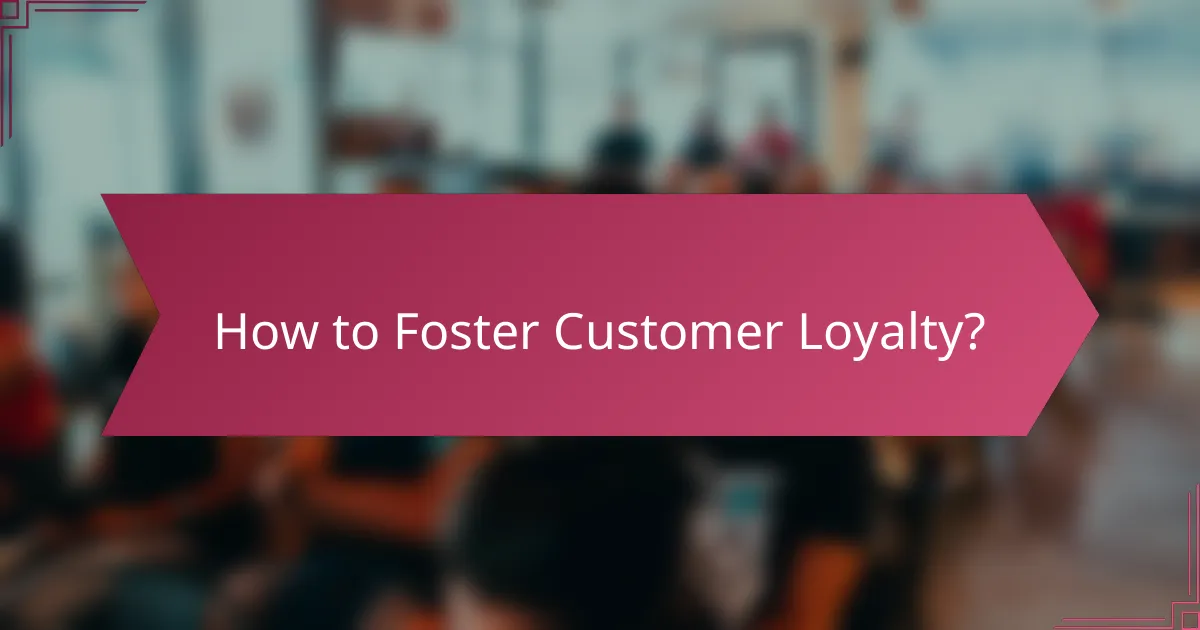
How to Foster Customer Loyalty?
To foster customer loyalty, businesses should focus on creating meaningful connections through consistent engagement, trust-building practices, and rewarding experiences. Implementing effective strategies can lead to long-term relationships and repeat business.
Loyalty programs
Loyalty programs are structured incentives designed to reward customers for their repeat business. These programs can include points systems, tiered rewards, or exclusive member benefits that encourage ongoing purchases.
When designing a loyalty program, consider offering rewards that resonate with your target audience, such as discounts, free products, or special access to events. Aim for simplicity in how customers earn and redeem rewards to enhance participation.
Exceptional customer service
Exceptional customer service is crucial for building trust and loyalty. Providing prompt, friendly, and knowledgeable assistance can significantly enhance the customer experience and encourage repeat business.
Train your staff to handle inquiries and complaints effectively, ensuring they have the tools to resolve issues quickly. Personalizing interactions, such as addressing customers by name or remembering past purchases, can further strengthen these relationships.
Regular follow-ups
Regular follow-ups demonstrate that you value your customers beyond the initial sale. This can include sending thank-you emails, requesting feedback, or checking in on their satisfaction with products or services.
Establish a schedule for follow-ups, whether it’s a week after purchase or quarterly check-ins. Use these opportunities to gather insights and show customers that their opinions matter, which can enhance loyalty.
Exclusive offers
Exclusive offers create a sense of privilege and appreciation among loyal customers. These can include special discounts, early access to new products, or invitations to private events.
To maximize the impact of exclusive offers, tailor them to your loyal customers’ preferences and purchasing habits. This personalization can significantly increase engagement and encourage customers to remain loyal to your brand.
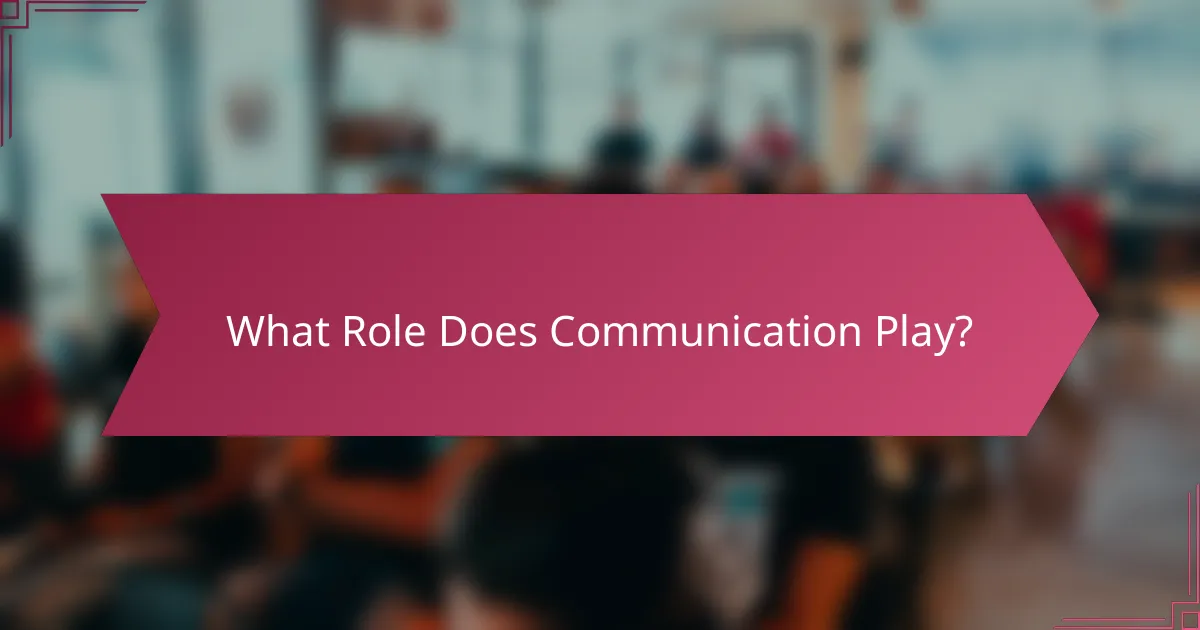
What Role Does Communication Play?
Communication is essential for building relationships based on trust, engagement, and loyalty. It facilitates understanding, fosters connections, and helps manage expectations between parties.
Building rapport
Building rapport involves creating a sense of trust and mutual respect. This can be achieved through active listening, showing empathy, and finding common interests. Simple gestures, like remembering names or personal details, can significantly enhance rapport.
In professional settings, sharing experiences or engaging in small talk can break the ice and strengthen relationships. Regular check-ins can also help maintain this connection over time.
Clarifying expectations
Clarifying expectations ensures that all parties are on the same page regarding goals and responsibilities. This can be done through direct conversations, written agreements, or regular updates. Clear communication reduces misunderstandings and builds trust.
It’s helpful to outline specific roles, deadlines, and desired outcomes. For example, in a project setting, discussing timelines and deliverables upfront can prevent conflicts later on.
Maintaining ongoing dialogue
Maintaining ongoing dialogue is crucial for sustaining relationships. Regular communication helps address issues promptly and keeps everyone informed. This can include scheduled meetings, feedback sessions, or informal check-ins.
Utilizing various communication channels, such as emails, phone calls, or messaging apps, can enhance engagement. It’s important to encourage open feedback and be receptive to concerns to foster a culture of trust and loyalty.

What Are the Key Metrics for Measuring Trust?
Key metrics for measuring trust include Net Promoter Score (NPS), customer satisfaction surveys, and retention rates. These metrics provide insights into customer perceptions and behaviors, helping businesses gauge their trustworthiness and overall relationship quality.
Net Promoter Score (NPS)
Net Promoter Score (NPS) measures customer loyalty by asking how likely customers are to recommend a company to others. Responses are typically rated on a scale from 0 to 10, categorizing customers into promoters, passives, and detractors.
A high NPS indicates strong customer trust and satisfaction, while a low score suggests areas needing improvement. Regularly tracking NPS can help businesses identify trends and make informed decisions to enhance customer relationships.
Customer satisfaction surveys
Customer satisfaction surveys assess how well a company’s products or services meet customer expectations. These surveys can include various question formats, such as Likert scales or open-ended questions, to gather qualitative and quantitative data.
To effectively use these surveys, keep them concise and focused on key aspects of the customer experience. Analyzing the results can reveal specific areas for improvement and help build stronger trust with customers.
Retention rates
Retention rates measure the percentage of customers who continue to do business with a company over a specific period. High retention rates often indicate strong trust and satisfaction, while low rates may signal issues that need addressing.
To calculate retention rates, divide the number of retained customers by the total number of customers at the start of the period, then multiply by 100. Monitoring this metric regularly can help businesses understand customer loyalty and the effectiveness of their trust-building efforts.
